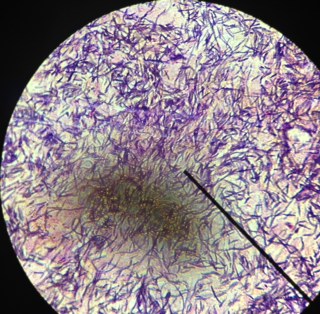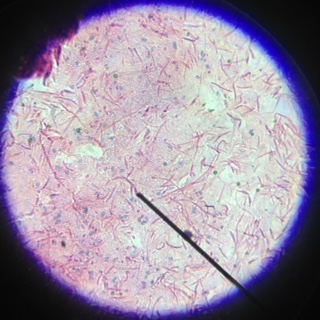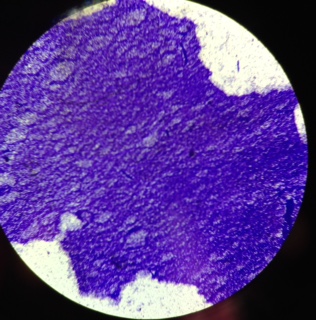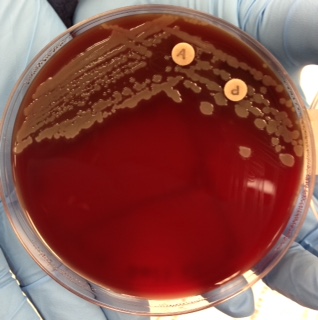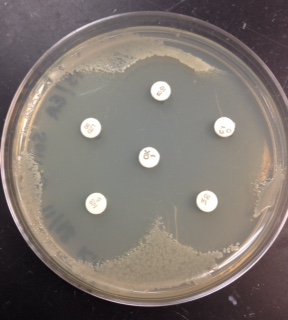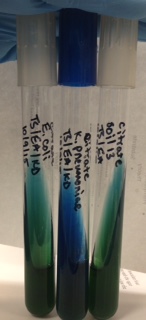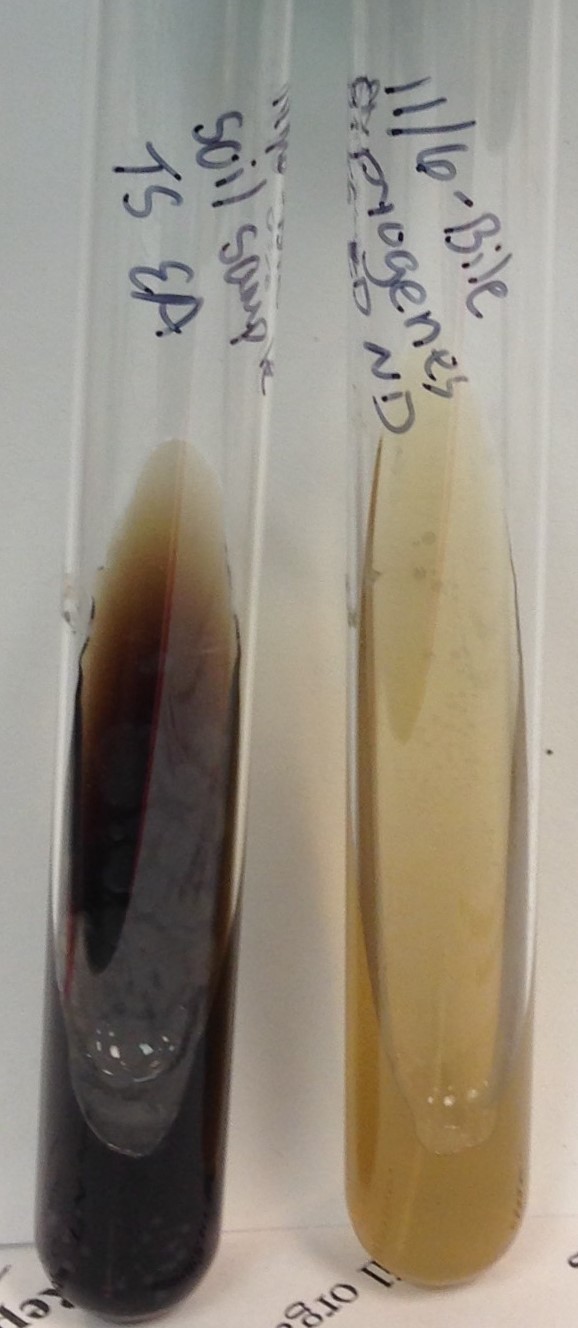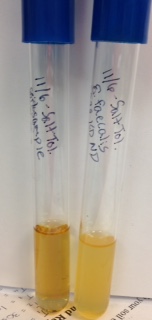Soil Sample Number 13
Classification
Domain: Bacteria; Phylum: Firmicutes; Class: Bacilli; Order: Bacillales; Family: Bacillaceae; Genus: Bacillus thermocopriae
Species
Bacillus thermocopriae
|
NCBI: Taxonomy |
The soil was collected from a pasture on my father's farm in Lexington, TX at 7:04 pm on September 2, 2015. The weather was dry and 89 degrees F and there had been zero rain in the past 7 days. The soil was collected in a shady area at the back of the pasture along the fence line from about 2 inches beneath the surface and kept at room temperature on the kitchen counter for 2 days.
Description and Significance
Soil sample number 13 when cultured on LB Agar is white, opaque, round, regular, small, shiny.
It is found to be gram positive rod and is in a strong chain formation. The endospore stain revealed that this sample does have endospores. When tested for zone of inhibitions against E. coli and S. aureus there were no zones. Endospores make the sample extremely resistant to drying, heat, lethal chemicals and radiation.
When tested for Bacitracin/Optochin susceptibilities, no zones of inhibition were observed. The first picture above shows the results of this test. We also tested our sample for antibiotic susceptibility against six different antibiotics to include: Novobiocin, Vancomycin, Sulfisoxazole, Bacitracin, Linezolid and Oxacillin. We observed our results to be susceptible to all six antibiotics. The second picture above shows the results of this test.
Genome Structure
16S Ribosomal sequence
Forward DNA Sequence
>DLF11-Forward_C11.ab1 GGANCCCGCNCGTGAGCGAGAAGGCCTTCGGNTTGTAAAGCTCTGTTGTTTGGGAAGAACGG TACCGGATTATCTGCTGGTGCCTTGACGGTACCTAACCAAAAAGCCCCGGCTAACTTCGTGCCAGCAGCCGCGGTAATACG TAGGTGGCAAGCGTTGTCCGGAATTATTGGGCGTAAAGCGCGCGCAGGCGGTCCTTTAAGTCGGATGTGAAATCCCCCGGCTCAACCGGGGAACGGC ATCGGAAACTGCGGGACTTGAGTGCGGAAGAGGAAGGCGGAATTCCCCGTGTAGCGGTGAAATGCGTAGATATGTGAAGG AACACCAGTGGCGAAGGCGACTTTCTGGACTGATACTGACGCTGAGGCGCGAAAGCGTGGGGAGCAAACAGGATTAGATACCCTGGTAGTCCACGCCGTAAACGATGA
Reverse DNA Sequence
>DLF12-Reverse_D11.ab1ACCACCTGTCACTCTGTCCCCCGAAGGGGAAATTCCTATCTCTAGGAGTGTCAGAGGA TGTCAAGACCTGGTAAGGTTCTTCGCGTTGCTTCGAATTAAACCACATGCTCCACCGCTTGTGCGGGCCCCCGTCAATTC CTTTGAGTTTCAGCCTTGCGGCCGTACTCCCCAGGCGGAGTGCTTAATGCGTTAGCTGCAGCACTAAAGGGCGGAAACCC TCTAACACTTAGCACTCATCGTTTACGGCGTGGACTACCAGGGTATCTAATCCTGTTTGCTCCCCACGCTTTCGCGCCTC AGCGTCAGTTACAGACCAGAAAGCCGCCTTCGCCACTGGTGTTCCTCCACATCTCTACGCATTTCACCGCTACACGTGGA ATTCCGCTTTCCTCTTCTGCACTCAAGTCCCCCAGTTTCCAATGACCCTCCACGGTTGAGCCGTGGGCTTTCACATCAGA CTTAAAGGACCGCCTGCGCGCGCTTTACGCCCAATAATTCCGGACAACGCTTGCCACCTACGTATTACCGCGGCTGCTGG CACGTAGTTAGCCGTGGCTTTCTGGTTAGGTACCGTCAAGGTACCGGCAGTTACTCCGGTACTTGTTCTTCCCTAACAAC AGAGCTTTACGACCCGAAGGCCTTCATCGCTCACGCGGCGTTGCTCCATCAGACTTTCGTCCATTGTGGAAGATTCCCTA
Cell Structure, Metabolism and Life Cycle
While studying this sample we found that it was very difficult to get the sample to grow on many different types of medias. We also found that it would usually only produce colonies in the first and second quadrants of our streak plates. Upon learning that our sample was a form of Bacillus we then knew that it preferred higher temperatures to grow. It produces alpha-amylase and/or oligo-1,6-glucosidase which allows it hydrolyze starch on starch agar. It also produces and secretes lipases as observed in the lipid hydrolysis test. It was observed in the oxidase test that our sample produced cytochrome c oxidase. Also, it proved in the decarboxylation test that the sample was positive for producing arginine, lysine and ornithine.
Upon more research we discovered that Bacillus thermocopriae is a fairly new discovered species with little known information. However, interestingly it shared similar characteristics with Bacillus drentensis.
We were not able to incubate our sample at a high enough temperature 50-60 degrees Celsius to really see if the microbial factors on our test patch plates really were negative or just weren't incubated at a high enough temperature.
Physiology and Pathogenesis
Positive Phenylethyl Alcohol growth
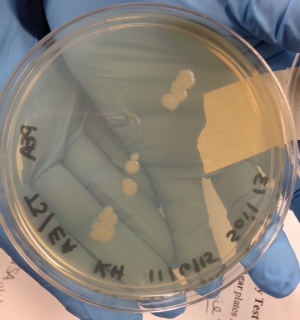
Soil sample number 13 tests positive for Glucose and Sucrose but is negative for Lactose when tested with Phenol Red Broth. It is positive for starch hydrolysis. When the casein hydrolysis test was performed nothing grew. After repeating the test still nothing grew. It was negative for gelatin hydrolysis as the tube remained solid and did not liquify. The DNA hydrolysis test was negative. Soil Sample number 13 was positive for lipid hydrolysis. The MR and the VP tests both were negative. It Simmons Citrate slant remained green which indicated a negative result for citrate. The SIM test resulted in a negative for motility, sulfur reduction and indole production from tryptophan. Our soil was positive for nitrate reduction. It also tested positive on the Triple Iron Sugar test for fermentation with acid accumulation. Soil sample number 13 was negative for Urea hydrolysis. Positive results for Arginine, Lysine and Ornithine as well as the Oxidase test were observed as well. The phenylalanine deaminase test was observed as a negative result. There was no growth on the EMB, HE and MAC plates which means the oil is negative for all of these tests as well. It is positive for Catalase. There was partial hemolysis observed on the blood agar plate. A test for susceptibilities to Bacitracin/Optochin were also performed on the same blood agar plate and yielded no zones of inhibition. Soil sample 13 was negative for Mannitol Salt tolerance. A positive results was observed for the Pheylethyl Alcohol agar plate. A positive result was also observed for the Bile Esculin test. However, a negative result yielded for the salt tolerance test. A test for antibiotic susceptibilities against six different antibiotics to include Novobiocin, Vancomycin, Sulfisoxazole, Bacitracin, Linezolid and Oxacillin was performed. The test results were inconclusive so the test was repeated. Also, there was a test for disinfectant susceptibilities against six potential disinfectants that included orange, 10% bleach, rosemary, 10% Lysol, tea tree and cinnamon. It was observed that the rosemary and the tea tree showed very weak zones of inhibitions.
References
Author
Page authored by Erin Andrews and Tabitha Sherer, students of Prof. Kristine Hollingsworth at Austin Community College.
